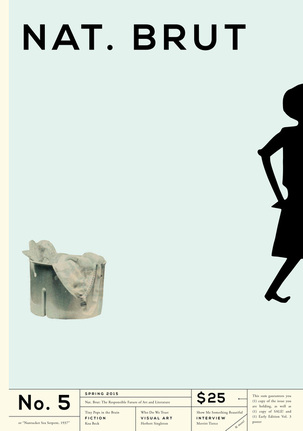Nat. Brut – Spring 2015
The Spring 2015 online issue of Nat. Brut carries a lot with it: fiction, flash fiction contest winners, poetry, art, film, animation, photographs. No matter what readers are looking for, they’re sure to find it somewhere in this issue. The Spring 2015 online issue of Nat. Brut carries a lot with it: fiction, flash fiction contest winners, poetry, art, film, animation, photographs. No matter what readers are looking for, they’re sure to find it somewhere in this issue.
Koa Beck’s “Tiny Pops in the Brain” opens the fiction section this issue, a well-placed piece that had me hooked. The story looks at sisters Madeline and Marie as their father begins dating again after their parents’ separation. The sisters first agree that the blonde Jocelyn must be a witch, but as younger Marie starts to take a liking to the new woman in their life, Madeline resists, her age giving her an awareness her little sister lacks. Beck writes with a quiet intensity, the little details about Madeline stringing readers along until the story’s climax.
Also in the fiction this issue is “Colonel Cheese is Closed on Mondays” by John Jodzio, winner of the 2014 Flash Fiction Contest. In this short piece, narrator Alexa follows her post-breakup passion of competitive eating, egged on by her eclectic cast of coworkers at Colonel Cheese. Despite the short length of the piece, Jodzio manages to “build up a bunch of static electricity” and bring Colonel Cheese and Alexa to life.
Kate Barss’s eerie and poetic second place piece “The Weight of Her” and Jacob Shelton’s third place “Receipts” both pack a punch, all the fiction in this issue doing a fantastic job of setting the stage for the rest of the writing.
The poetry in this issue is led by two pieces by Christine Hamm. “Self-Portrait as a Series of Jobs and Horses” begins:
Now I’m polishing my saddle with Murphy’s Oil Soap on the floor of the living room, surrounded by newspapers, toothbrushes and jars. The TV shows a white clay figure falling down stairs. His eyes are blue thumb-prints.
Now you’re picking up a wooden mallet, the meat tenderizer, from a kitchen drawer and going to my brother’s bedroom to beat him.
and continues with force until the end, a force that continues to overflow into “Self-Portrait as Nine Sisters.”
In “Headline News,” Joan Naviyuk Kane recycles a history of the Alaskan Native via headlines from the Nome Nugget from 1901 to 1976. Written in all capital letters, the poem reads as a new headline, growing more and more dismal until the sobering end.
In the Features section, “Photo Box Vol. 2″ showcases photos curated by Rebecca Weisberg who opens her selections with:
[. . .] The reality of the American dream exists in marginal and vulnerable places, where stagnant social mobility and desperate sexuality collide, where down and out people have no buffers between themselves and life’s hard knocks. This collection hopes to find the hidden seam between the America on display and the America that exists underneath.
Photos of boys holding guns and men flexing perfect muscles are juxtaposed by women in violent but erotic poses. The collection is both familiar and chilling. The other four Features are all worth spending some time in, from an interview with Merritt Tierce, author of novel Love Me Back, to “Early Edition Vol. 3,” which is packed with comics and art.
Moving on to the film & animation section, “Rhinoceros” is a 1965 animation by Polish illustrator Jan Lenica. An eleven minute reimagining of Eugene Ionesco’s absurdist play, the cartoon applies herd mentality literally as the people the main character comes across begin to turn into rhinos.
Lana Nichols’s animation “Monogram” mimics the feel of point-and-click flash games while looking at Robert Rauschenberg’s creation of his own piece by the same name. If readers of this issue have 20 extra minutes to spare after devouring the great writing, definitely take the time to watch the online screener of “The Astronaut and the Star,” “an exploration of the threat of femininity. Harkening back to tropes of the film noir era, the story revolves around an oppressive Femme Fatale and the young boy she has mysteriously entrapped in her house” which carries a Twin Peaks feel along with it.
From short films to even shorter fiction, this issue has a lot to digest—even more so if readers make the wise decision to pick up a copy of the print edition, where they can find content unavailable online. Each piece that Nat. Brut offers has the ability to haunt readers long after they’ve walked away from their computer screens.
[www.natbrut.com]






